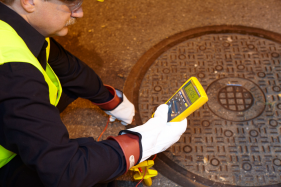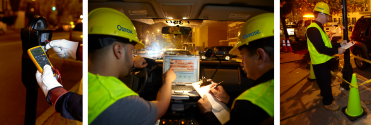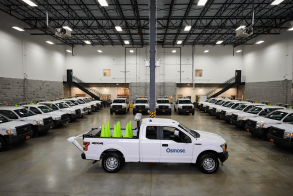Using Mobile Contact Voltage Testing to Manage Low-Voltage Underground Cable
 The global installed base of low-voltage, underground cable is aging and deteriorating. Contact voltage can occur when there is a single failure anywhere along the length of a low-voltage cable system and can lead to a number of serious occurrences. These occurrences have become increasingly commonplace and can include manhole fires and explosions, pedestrian shocks, electrocutions, and outages.
The global installed base of low-voltage, underground cable is aging and deteriorating. Contact voltage can occur when there is a single failure anywhere along the length of a low-voltage cable system and can lead to a number of serious occurrences. These occurrences have become increasingly commonplace and can include manhole fires and explosions, pedestrian shocks, electrocutions, and outages.
Contact voltage, often inaccurately referred to as “stray voltage,” is defined by the IEEE as “a voltage resulting from electrical faults that may be present between two conductive surfaces that can be simultaneously contacted by members of the general public or animals.” Contact voltage is caused by power system fault current as it flows through the impedance of available fault current pathways. Exposure to contact voltage can be hazardous to people and pets, causing injury and, in some cases, even death. Contact voltage can occur at any place where electric cable breaks down from mechanical, thermal, chemical, or electrical stress.
Once low-voltage cable insulation has failed, breaches in the insulation allow for conductive materials, including water, to form conductive pathways across the insulation. Current traveling in these conductive pathways can energize surface level objects and heat the insulation to temperatures high enough to begin thermal degradation of the insulation system. This degradation is often anaerobic, which permits the formation of significant quantities of carbon monoxide in addition to other combustible gases.
These faults only exist underground and are undetectable by visual inspection. Further, secondary underground systems are designed to supply current with very high levels of reliability. These underground systems are designed to be fault-tolerant to avoid nuisance interruptions. Differentiating between load current and fault current in normally unbalanced systems is extremely difficult due to the relatively low current that is necessary to initiate and sustain contact voltage faults. As a result, protective devices including limiters and fuses are insensitive and allow contact voltage faults to persist indefinitely.

The Osmose SVD-3 patented mobile contact voltage detection technology pinpoints system deficiencies stemming from aging and damaged underground cable, providing utilities with unmatched intelligence into the health of their underground cable systems. To date, the SVD-3 system has identified over 200,000 low-voltage distribution system faults for utilities across North America and Europe.
Each night, a fleet of SVD-3 trucks is deployed to scan large-scale underground systems and detect contact voltage faults before they impact utilities and the public. Truck mounted sensor systems continuously monitor electric field signals and search for anomalies as the vehicle drives down the street. This technique allows us to quickly and reliably detect voltages on all nearby structures and surfaces including streetlights, manholes, fences, roadways, and sidewalks.
 Our technology is extremely sensitive and can detect as little as one volts of alternating current (VAC) from 30 feet away while moving at speeds up to 25 mph. Each detection made by the SVD-3 represents an actual system breakdown and offers the utility an opportunity to make a repair and avoid a serious future event. This system allows for enhanced public safety, improved energy efficiency, and optimized asset management and reliability.
Our technology is extremely sensitive and can detect as little as one volts of alternating current (VAC) from 30 feet away while moving at speeds up to 25 mph. Each detection made by the SVD-3 represents an actual system breakdown and offers the utility an opportunity to make a repair and avoid a serious future event. This system allows for enhanced public safety, improved energy efficiency, and optimized asset management and reliability.
The use of Osmose's SVD-3 technology allows utilities to identify and replace failing cable before it has a chance to evolve into an event that impacts safety or reliability. This is how we ensure that the right cable is replaced at the right time.
For more information about mobile contact voltage detection services, contact your local Osmose representatives:
Middle and East Tennessee:
Patrick Kraft
Director, Business Development
pkraft@osmose.com
336-469-2762
West Tennessee
Shane Heartsill
Director, Business Development
sheartsill@osmose.com
901-494-2129
.png?width=243&name=Osmose-logo-(white).png)